Serviços Personalizados
Journal
Artigo
Indicadores
-
 Citado por SciELO
Citado por SciELO -
 Acessos
Acessos
Links relacionados
-
 Similares em
SciELO
Similares em
SciELO
Compartilhar
Revista mexicana de ciencias agrícolas
versão impressa ISSN 2007-0934
Rev. Mex. Cienc. Agríc vol.7 no.4 Texcoco Mai./Jun. 2016
Articles
Food products marketed in the “Plaza” of Villa de Zaachila, Oaxaca, Mexico
1 Ciencias en Productividad de Agroecosistemas-Instituto Tecnológico del Valle de Oaxaca. Ex Hacienda de Nazareno Xoxocotlán, Oaxaca, México. Tel: 01(951) 5170788. C. P. 71230. (guzk87@hotmail.com; judithruizl@hotmail.com; giscampos@hotmail.com; geraro65@gmail.com; jenriquezdelvalle@yahoo.com).
The "market day" is a traditional trade practice symbolizing a cultural heritage, where traders come from different parts of the region. The objective of this research was to determine the type and quantity of food products marketed in the "market day" of Villa de Zaachila, by direct observation, interviews and surveys of traders January 2013 toApril 2014. According to criterion traders, the products were grouped in fruits, vegetables, seeds, herbs and other derivatives foods. Fruits accounted for the largest amount sold (54.8%). The town from which the products influenced the amount (kg) that reaches "the Plaza". The highest percentage (53.6%) of merchants selling smaller amounts to 50 kg, were classified as selling homegrown.
Keywords: barter; own traders; traders “regatones”; traditional trade
El “día de plaza”, es una práctica de comercio tradicional que simboliza un patrimonio cultural, donde acuden comerciantes de distintas partes de la región. El objetivo de esta investigación fue determinar el tipo y cantidad de productos agroalimentarios comercializados en el “Día de plaza” de la Villa de Zaachila, mediante observación directa, entrevistas y encuestas dirigidas a comerciantes de enero del 2013 a abril de 2014. De acuerdo al criterio de los comerciantes, los productos se agruparon en frutas, verduras, hortalizas, semillas, hierbas aromáticas y otros alimentos derivados. Las frutas representaron la mayor cantidad comercializada (54.8%). La localidad de donde provienen los productos influyó en la cantidad (kg) que llega a “la Plaza”. El porcentaje más alto (53.6%) de comerciantes que venden cantidades menores a 50 kg, fueron los clasificados como vendedores de cosecha propia.
Palabras clave: comerciantes “propios”; comerciantes “regatones”; comercio tradicional; “trueque”
Introduction
The "market day" is a traditional practice of trade and cultural life of the people of Oaxaca. "The squares" are characterized by intense marketing and direct exchange between producers in the region (Pare, 1975), sites such producers are the core of these markets (Arellanes and Casas, 2011). In the Central Valleys of Oaxaca, Mexico, the "market days" are strategically located in places where people come more easily for buying and selling their products.
According to Diskin and Cook (1975) and Warman (1982), the prehispanic markets still have a presence in traditional markets as they remain in the same locations where they were in the past. An example of this is the community of La Villa de Zaachila, Oaxaca, founded in the thirteenth century after Christ (Barabas, 1999). In this Villa, thursdays around 5 a.m., vendors are installed in the center of the town, from the surrounding towns, these as Malinowski and de la Fuente (1957), are classified as "own, regatones and itinerant". One of the most important traders are "own" which are producing mainly for self-consumption (Vasquez et al., 2009), because the volume of production does not allow them to access other trade, so most only they sell their surplus. These, sell food products harvested in their fields or backyards. Within this context, the priority of peasant logic of subsistence, is the satisfaction of the need for food (Bellucci, 2002) and the maximum monetary gain (Gatti, 2009), so occasionally they practice barter (Arellanes and Casas, 2011; Ferraro, 2002; Tocancipa, 2008), with a preconception between the merchant and consumer (Leon, 2010).
The objective of this research was to estimate the amount of food and agricultural products from local production systems present in the "market day" of Villa de Zaachila, Oaxaca, from inception to commercialization.
Materials and methods
Location of the study area
The research was conducted in "the square" in the municipality of Villa de Zaachila, Oaxaca, Mexico, between 16° 52' and 17° 02' north latitude, 96° 39' and 96 ° 52' longitud west; altitude of 1 500 m. The climate is dry, semi-dry and semi-warm; semi-warm humid with rains in summer; and temperate subhumid with summer rains. The temperature fluctuates between 16 °C and 22 °C. The rainfall varies between 600 and 800 mm (INEGI, 2012).
Obtaining information. Sampling was conducted during the period february 2013 to april 2014, seven times during the day Thursday, the day of the week is done the "market day" in the Villa de Zaachila. The target population was 250 retailers Introduction
The "market day" is a traditional practice of trade and cultural life of the people of Oaxaca. "The squares" are characterized by intense marketing and direct exchange between producers in the region (Pare, 1975), sites such producers are the core of these markets (Arellanes and Casas, 2011). In the Central Valleys of Oaxaca, Mexico, the "market days" are strategically located in places where people come more easily for buying and selling their products.
According to Diskin and Cook (1975) and Warman (1982), the prehispanic markets still have a presence in traditional markets as they remain in the same locations where they were in the past. An example of this is the community of La Villa de Zaachila, Oaxaca, founded in the thirteenth century after Christ (Barabas, 1999). In this Villa, thursdays around 5 a.m., vendors are installed in the center of the town, from the surrounding towns, these as Malinowski and de la Fuente (1957), are classified as "own, regatones and itinerant". One of the most important traders are "own" which are producing mainly for self-consumption (Vasquez et al., 2009), because the volume of production does not allow them to access other trade, so most only they sell their surplus. These, sell food products harvested in their fields or backyards. Within this context, the priority of peasant logic of subsistence, is the satisfaction of the need for food (Bellucci, 2002) and the maximum monetary gain (Gatti, 2009), so occasionally they practice barter (Arellanes and Casas, 2011; Ferraro, 2002; Tocancipa, 2008), with a preconception between the merchant and consumer (Leon, 2010).
The objective of this research was to estimate the amount of food and agricultural products from local production systems present in the "market day" of Villa de Zaachila, Oaxaca, from inception to commercialization.
Materials and methods
Location of the study area
The research was conducted in "the square" in the municipality of Villa de Zaachila, Oaxaca, Mexico, between 16° 52' and 17° 02' north latitude, 96° 39' and 96 ° 52' longitud west; altitude of 1 500 m. The climate is dry, semi-dry and semi-warm; semi-warm humid with rains in summer; and temperate subhumid with summer rains. The temperature fluctuates between 16 °C and 22 °C. The rainfall varies between 600 and 800 mm (INEGI, 2012).
Obtaining information. Sampling was conducted during the period february 2013 to april 2014, seven times during the day Thursday, the day of the week is done the "market day" in the Villa de Zaachila. The target population was 250 retailers of food products, based on the census of traders registered in 2011 by the Delegate Council of Tianguis and Markets Municipality of Zaachila, Oaxaca. Sampling intensity was 27% (69 merchants) using a confidence level of 95%. Through direct interviews and surveys observation, food products and their origin they were identified. Malinowski proposed methodologies were used and De la Fuente (1957), Martinez et al. (2006), and Arellanes and Casas (2011) research on regional markets. Interviews were conducted with adults, most senior trade within "the square". For the implementation of those surveys sites within the "square" in which most traders’ conglomeration of local food products was selected.
The variables evaluated were: food products that sell, origin of the product, quantity (kg) of each product which the trader leads to "square" for sale, sold (kg) at the end of the day number, and personal information of the merchant. The amounts were estimated to weigh on a scale each piece, lot or bags of each product which the trader exposed in office, data were taken as a basis for inferring the total number of pieces in piles or bags, as well as the quantity sold at the end day of "square".
Analysis of the information. By analyzing frequency traders rated according to the total amount of products sold was performed, and the frequency of these products in the sampling periods analyzed. All analyzes were performed using the statistical package NCSS (2013), online demo.
Results and discussion
The food products sold in "square" of the Villa de Zaachila. Places are spaces where peasant production and other products are presented for marketing (Carrasco, 1999). An example is "square" of the Villa de Zaachila in which joins a variety of food products. According to the criterion of traders in this square, food products are classified as fruits, vegetables, herbs, seeds and other foods. Fruits accounted for the largest amount (54.8%) sold (Figure 1). These groups changed in proportion during different periods of marketing, their presence in this type of traditional trade represents the seasonality of products of local production systems (Tables 1 to 5). Warman (1982) argued that in the plazas commercial activity is determined by circumstances associated with the agricultural cycle. The Zaachila municipality has a gradient of climates throughout the year, allowing a variety of crops that are marketed in the "market day".
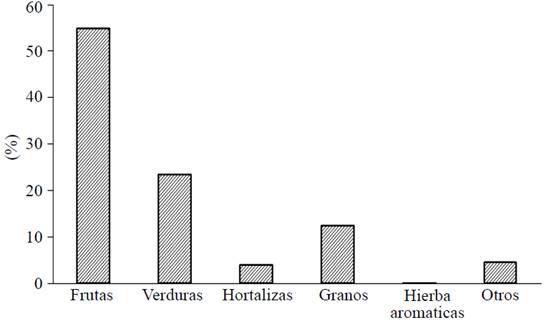
Figure 1 Proportion of food products marketed in "square" of the Villa de Zaachila, Oaxaca, according to the criteria of traders.
Table 1 Relative frequency of fruit marketed in different sampling periods in the “market day” of Villa de Zaachila.
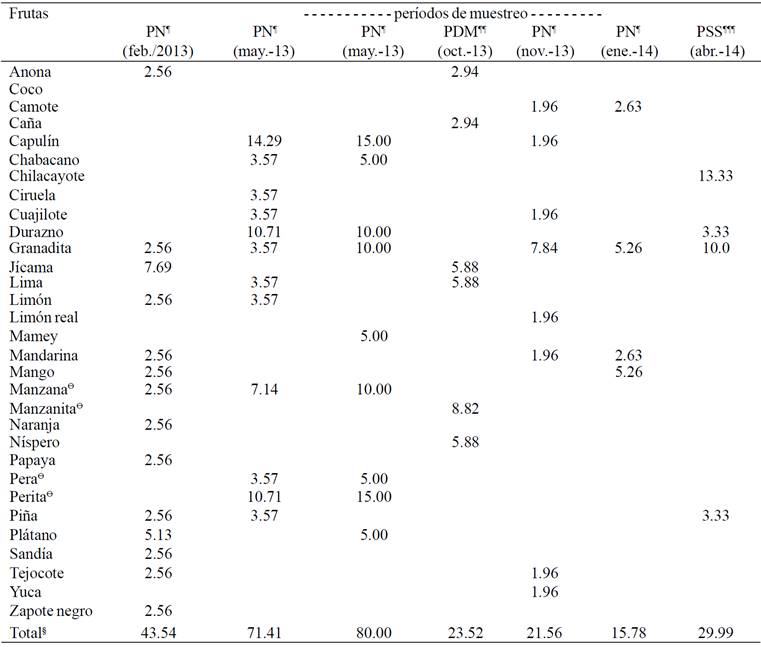
Table 2 Relative frequency of vegetables marketed in different sampling periods in the “market day” of Villa de Zaachila.
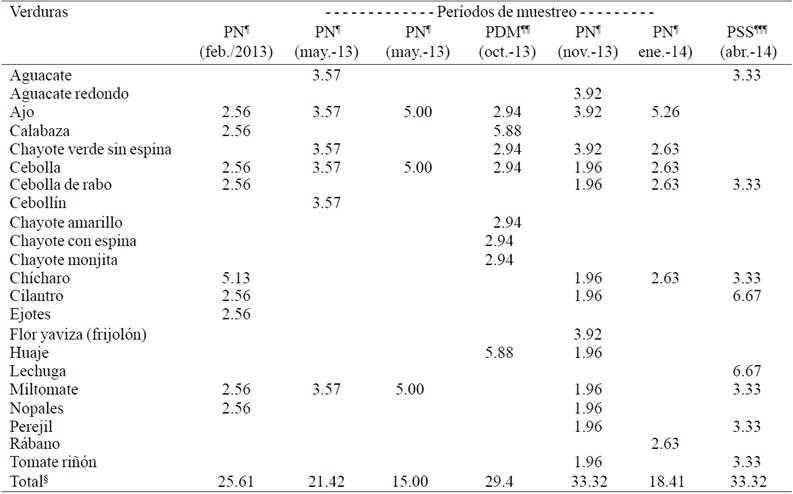
Table 3 Relative frequency of vegetables marketed in different sampling periods in the “market day” of Villa de Zaachila.

Table 4 Relative frequency of aromatic herbs, grains and seeds marketed in different sampling periods in the “market day” of Villa de Zaachila.

Table 5 Relative frequency of aromatic herbs, grains and seeds marketed in different sampling periods in the “market day” of Villa de Zaachila.
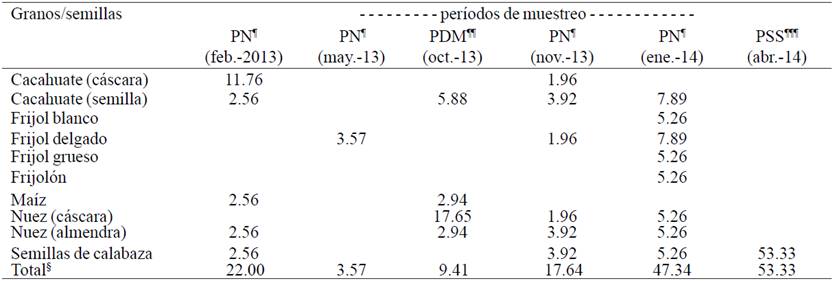
In a "normal day plaza" during the months of february and may (Table 1) it was found that the highest percentage of marketing presented it fruits in general (71.4 to 80%) projecting the chokecherry (Prunus capulli), plum (Prunus salicin), cuajilote (Parmentiera aculeata), criollo peach (Prunus persica), granadita (Passif lora ligularis), creole apple (Malus sylvestris) and creole perita (Pyrus communis), mostly from Clavelinas, Santa Ines del Monte and San Miguel pears, neighboring villages of the town of Zaachila (INEGI, 2012). the proportion of food products changed depending on the season and some festivities in the village as the "Day of the dead and Easter", and products that in every town in the region is harvested.
Characteristically find a very select group of traders during the days before the celebration of the festivities. In the "Day of the dead" in Oaxaca, Mexico, the dead by placing an offering of fruits and foods are honored. In "square" greater homogeneity of food products, where fruits, vegetables, grains, seeds and other specific foods was observed they were found in most positions merchants (Tables 1, 2, 5 and 6).
Table 6 Relative frequency of other foods marketed in different sampling periods in the “market day” of Villa de Zaachila.
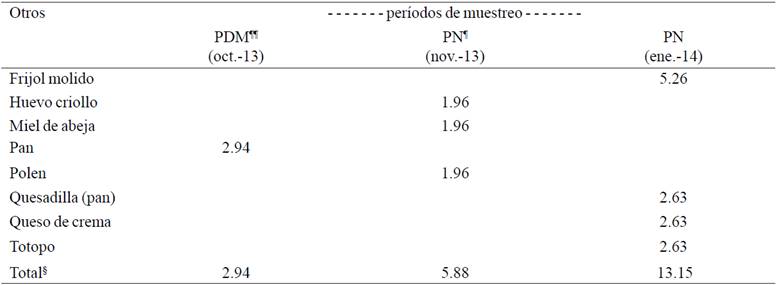
During the "Square easter", the behavior of these varied products, that is, the presence and amount was reflected by the requirements and habits of specific consumption of regional food system (Melendez and Cañez, 2010) in this period (waking). Therefore, foods mainly agricultural origin, were found in most positions of traders. In this period, the presence of fruit 29.99% ranked as the chilacayota, granadita, creole pineapple (Table 1); They accounted for 33.32% vegetables such as lettuce, cilantro, onion tail, avocado, peas, creole miltomate; and 16.67% vegetables, such as zucchini Creole, water chile and solterito chile (Tables 2 and 3).
In "Square Easter" herbs scent occupied 16.66%, the increased presence of bay leaves, basil and epazote (Table 4) was reported consumption is influenced by cultural practices and customs of the population (Garcia et al., 2008; Londoño-Aldama, 2011; Castellon, 2012). Another group of important agricultural products of this marketing period occupied it grains and seeds, with pumpkin seeds, known as "nuggets", the product most often in positions of traders (Table 5) that usually they were intermediaries (ferrules).
Typology of traders. In the "Plaza" of Villa de Zaachila, it is characteristic find the presence of traders originating from the same region, who have for sale various quantities of products from their backyards (Bonilla et al., 2013) or annual crops. These range from the housewife who sells bunches of cilantro, until the annual harvest of the farmer ("own") without seeking the maximum monetary gain (Gatti, 2009; Bellucci, 2002), which forces them to develop within an informal economy (Belaza, 2006). Therefore, a classification according to the quantities of food products every trader sold in the "market day" where "own" low-level (sales ≤ 50 kg/square) represent the largest proportion was obtained (56.3%) compared to middlemen or "regatones" (27.6%), These small businesses are the identity of each place (Authier, 2007). Only 7.2% of equity and 2.9% off errules are classified as high level because market > 150 kg and ≤ 1 848 kg of the product per market day (Table 7). This will depend on the period or season in which the various local food products are placed. Malinowski and La Source (1957), Diskin and Cook (1975), Pare (1975) and Arellanes and Casas (2011) have argued that the core elements of a traditional market are the products harvested by farmers in the region.
The presence of traders according to the classification obtained varied during different periods in the marketing of food products. The presence of the three groups of traders classified as low, medium and high level, both "own" as the "hucksters" during the month of February in a "normal day plaza" found. Otherwise it'll happen throughout the month of May which were present only "own" low-level (Figure 2).
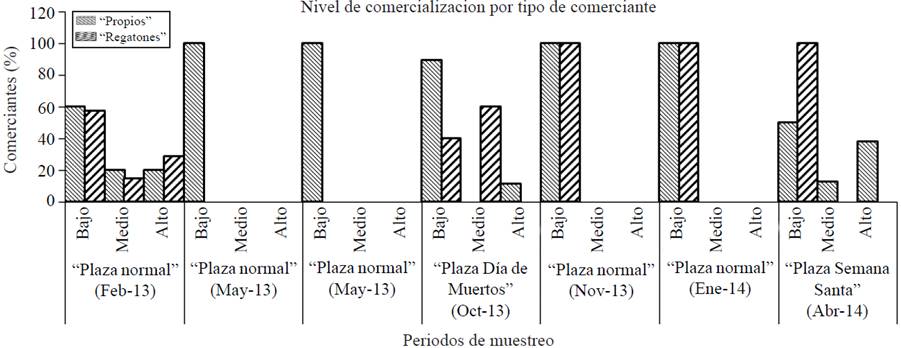
Figure 2 Proportion of traders according to type (own, regaton), level of marketing and sampling period.
However, in specific periods such as the "Square Day of the dead" and "Square Easter", the presence of traders around the marketing of food products change drastically, since the frequency homogenised, being present in this activity traders all three levels. Traders low level (≤ 50 kg) excelled in both periods, of which own occupied the highest percentage in the "Day of the Dead space". Otherwise the day "Easter Square" where local intermediaries "regatones" predominated in full (100%). While high-level traders (150 to 1,848 kg) that sell local products, generally in minimum percentages (0 to 37.5%) compared to middle and low.
Marketing of local food products. The agricultural sector provides the basis on which farmers can seek other economically viable alternatives (Mercado, 2007) as is trade. Through an X 2 test it was shown that the amount of food products marketed in "square" of the Villa de Zaachila significantly dependent (p= <0.0001) of sampling periods and locations where the products come from.
The 91.67% of the products sold are found in a range of 0.7 to 50 kg, while 4.17% corresponded to those sold in quantities greater than 50 kg. This makes clear that the frequencies of sales in this type of traditional commerce, products that do not exceed 50 kg for "market day" are. While in the "normal place" in February and "Day of the dead" amounts (kg) sold in the three intervals tested were reported, and it is this date where the greatest diversity of products presented in comparison to the rest of sampled periods (Table 8).
Table 8 Test X 2 of the amount of food products marketed in the “square” of the Villa de Zaachila according to their origin.

In 16 localities from which the food products of different production systems in the region, these are neighboring municipalities and agencies to La Villa de Zaachila were identified. La Villa de Zaachila and Santa Ines del Monte protrude quantities (kg) traded (35.83% and 28.33%, respectively). The 91.67% of the total weight of the products, are sold in small amounts (0.7 to 50 kg).
The 4.17% of the products sold in quantities greater than 150 kg came from the Central de Abastos Oaxaca City, Carnations, San Miguel Peras, Ocotlan de Morelos, Zaachila, Costa and Santa Ines del Monte. Luke Tlanichico sold only amounts> 50 and <150 kg, which represents 0.42% of the total weight of products (Table 9).
Table 9 Test X 2 of the amount of food products marketed in the "square" of the Villa de Zaachila according to their origin.
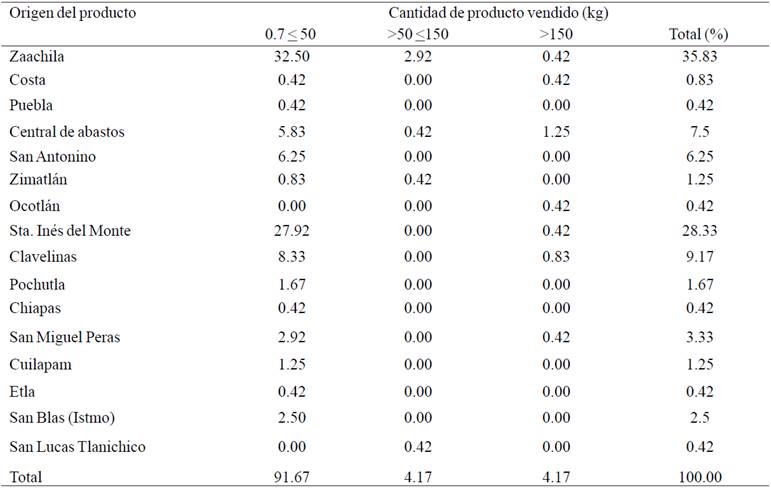
During the period studied, the representative products of each locality were identified by frequency analysis. In the Villa de Zaachila more frequent nut and peanut was found; the ferrules addition to purchase their products elsewhere, acquired from the central supply products such as tangerine, banana, onion and chile water. It was also found that the capulín and granadita is characteristic of Santa Ines del Monte, Carnations and San Miguel Peras, only (Figure 3).
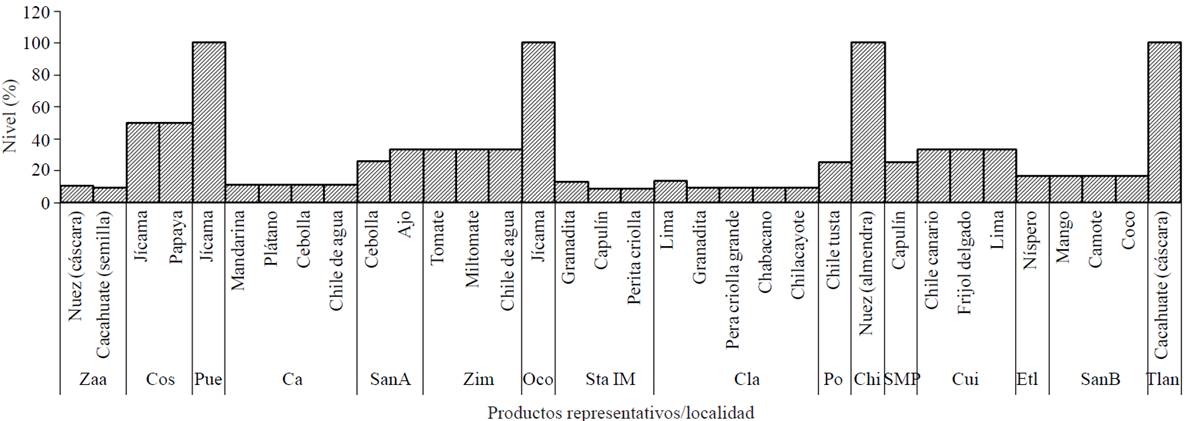
Figure 3 Food products representative of each locality. Zaa= Zaachila; Cos= Costa; Pue= Puebla; Ca= Central of Abastos, Cd. of Oaxaca; SanA= San Antonino; Zim= Zimatlán of Alvarez; Oco= Ocotlan; Sta IM= Santa Ines of the Monte; Cla= Clavelinas; Po= Pochutla; Ch= Chiapas; SM = San Miguel Peras; Cui= Cuilapam; Etl= Etla; San B= San Blas Atempa; Tlan= Tlanichico.
Conclusions
In the "square" of the town of Zaachila, food products vary in proportion (frequency) during different periods of marketing. Seasonality of regional production systems are factors that significantly influence the presence of these. According to the criterion of traders, food products were classified in fruits, vegetables, herbs, seeds and other foods.
The origin of food products influences the amount (kg) marketed in "Square". The town of Ocotlan had the highest amount of product (1 600 kg) with 87.50% of sales. The towns of San Miguel Peras, Cuilapam of Guerrero, Etla and San Lucas Tlanichico reported the highest percentage of sales (100%).
Traders Homegrown (own) low level (<50 kg), accounted for the largest percentage of sales (53.6%). The greatest diversity of products traded was in the "Day of the dead Square".
Literatura citada
Arellanes, C. y Casas, F. A. 2011. Los mercados tradicionales del Valle de Tehuacán-Cuicatlán: antecedentes y situación actual. Asociación Nueva Antropología. 4 (74): 93-123. [ Links ]
Authier, J. 2007. Relaciones con los comercios y modos de habitar. Los barrios centrales gentrificados en Francia Alteridades. Universidad Autónoma Metropolitana Unidad Iztapalapa (UAM- UI). México. 17(33):9-20. [ Links ]
Barabas, A. 1999. Gente de la palabra verdadera. El grupo etnolingüístico zapoteco”. In: Barbaras, A. y Bartolomé, M. (Coord). Configuraciones étnicas en Oaxaca. Perspectivas etnográficas para las autonomías. Conaculta-INI, México. I:57-132. [ Links ]
Belaza, V. J. 2006. Reseña de "Negocios étnicos. Los comercios de los inmigrantes no comunitarios en Cataluña" de Carlota Solé y Sonia Parella Reis. Rev. Española Invest. Soc. 116:312-315. [ Links ]
Bellucci, S. A. 2002. La herbolaria en los mercados tradicionales. Rev. Centro Invest. 5(018-017):63-70. [ Links ]
Bonilla, A. M.; Salcido, R. B.; Paredes, S. J.; Aguirre, Á. L.; Méndez, C. M. y Hernández, R. M. 2013. La diversidad hortícola para la seguridad alimentaria en municipios marginados del estado de Puebla. Ra Ximhai. 9(2):151-163. [ Links ]
Carrasco, T. 1999. Los productores del campo en Oaxaca. Alteridades. Universidad Autónoma Metropolitana Unidad Iztapalapa (UAM- U-I). México. 9(17):95-104. [ Links ]
Castellón, M. E.; Chávez, S. J.; Carrillo, R. J. y Vera, G. A. 2012. Preferencias de consumo de chiles (Capsicum Annuum L.) nativos en los Valles Centrales de Oaxaca, México. Rev. Fitotec. Mex. 35(5):27-35. [ Links ]
Diskin, M. y Cook, S. 1975. Mercados de Oaxaca. Instituto Nacional Indigenista y Secretaría de Educación Pública. México. 239 p. [ Links ]
Ferraro, E. 2002. Reseña de "Trueque intercambio y valor: un acercamiento antropológico". De Humphrey, C. y Hugh-Jones, S. (Comp.) Iconos. Rev. Cienc. Soc. Facultad Latinoamericana de Ciencias Sociales Ecuador. 14:150-152. [ Links ]
García, C.; Pardío, L. J.; Arroyo, A. P. y Fernández, G. V. 2008. Dinámica familiar y su relación con hábitos alimentarios. Estudios sobre las Culturas Contemporáneas. 14(027):9-46. [ Links ]
Gatti, C. 2009. El fenómeno del trueque: una mirada sociológica. Revista Pueblos y Fronteras Digital, Universidad Nacional Autónoma de México (UNAM). 5(8):264-286. [ Links ]
INEGI. 2012. Perspectiva estadística. Oaxaca. Publicación trimestral. [ Links ]
León, S. C. 2010. El comercio en la vía pública y el imaginario social en resistencia. El caso del tianguis de La Bola El Cotidiano. Universidad Autónoma Metropolitana Azcapotzalco (UAM-UA). México. 159: 93-100. [ Links ]
Londoño-Aldama, E. y Navas, R. M. 2011. Comercio tradicional de productos de gran consumo en Colombia: movilidad del consumidor. Orinoquia. 15 (1): 103-111. [ Links ]
Malinowsky, B. y De la Fuente, J. 1957. La economía de un sistema de mercados en México: un ensayo de etnografía contemporánea y cambio social en el valle de mexicano, INAH. México. 187 p. [ Links ]
Martínez, M. D.; Alvarado, F. R.; Mendoza, C. M. y Basurto, P. F. 2006. Plantas medicinales de cuatro mercados del estado de Puebla, México. Boletín de la Sociedad Botánica de México. 79:79-87. [ Links ]
Meléndez T. J. M. y Cañez, de la F. G. 2010. La cocina tradicional regional como un elemento de identidad y desarrollo local. El caso de San Pedro El Saucito, Sonora, México. Estudios Sociales. Coordinación de Desarrollo Regional Hermosillo. México. 17(1):182-204. [ Links ]
Mercado, M. J. 2007. El concepto dinámicas familiares rurales de reproducción y la pertinencia de su aplicación en la sociología rural. Cuicuilco. 14(40):11-35. [ Links ]
NCSS. 2013. Guiders Lines. Version 9. USA. [ Links ]
Paré, L. 1975. Tianguis y economía capitalista. Nueva antropología. Mexico. 1(2):85-93. [ Links ]
Tocancipá, F. J. 2008. El trueque: tradición, resistencia y fortalecimiento de la economía indígena en el Cauca. Rev. Est. Soc. Universidad de Los Andes. Colombia. 31:146-161. [ Links ]
Vásquez, S. V.; Vizcarra, B. I.; Quintanar, G. E. y Lutz, B. B. 2009. Heterogeneidad en las prácticas agrarias como estrategia de adaptación a los procesos globales. Caso de Santa Cruz (Chilapa, Guerrero, México). Convergencia. Rev. Cienc. Soc. 16 (50):79-106. [ Links ]
Warman, A. 1982. Acciones y costumbres centenarias. In: Mercados indios. INI-FONAPAS. México. 65 p. [ Links ]
Received: March 2016; Accepted: June 2016











 texto em
texto em 



